So the idea of an all-green planted tank bores you and you want to make your aquascape more colorful.

I’ve found that red aquarium plants are the path to a more attractive tank, and contrary to popular belief, there are some species that may be suitable for beginners.
Typically, looking after red, pink, or purple aquatic plants requires strong lighting, CO2 injections, and overall good plant husbandry.
However, my research and experience show that some species can be rather easy to grow under low-tech conditions.
Obviously, the colors in a low-maintenance environment would not be as bright.
That being said, let me list some ideas for red aquarium plants that can make your aquascape tank more attractive.
13 Red Aquarium Plants for a More Colorful Aquascape
To put together an impressive planted tank you should – from a designer’s point of view – keep plants with a variety of leaf shapes and colors.
During my research for this list I stayed flexible and made sure to handpick plants with diverse color shades and leaves. This way you could potentially combine them and achieve the colorful look you’re after.
Also, when I mention that a plant is suitable for a novice aquarist, I don’t mean an absolute beginner to the hobby.
I mean someone who’s new to keeping plants that are not green in their tank.
So you need to be at least accustomed to the basics of keeping aquatic plants.
That being said, have a look at the red aquarium plants that could go in your planted tank:
1. Ludwigia natans “Super Red” (Ludwigia Palustris)
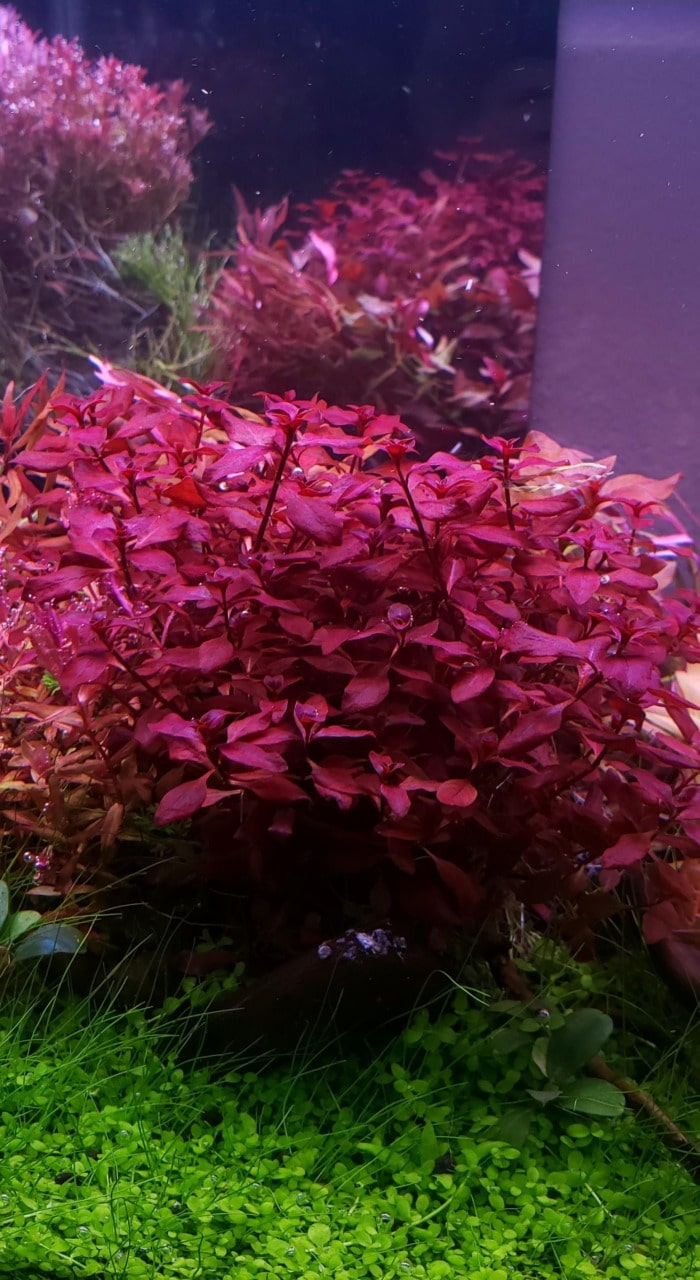
by kvlopsia
- Suitable for a Beginner: Yes;
- Suggested Lighting: Strong;
- Growth Rate: Fast if done properly.
The Ludwigia species Red, or Super Red, used to be known as Ludwigia natans, but later became Ludwigia palustris.
Despite this, you can still find it under both labels in fish stores or online. This splendid red aquarium plant belongs to the Ludwigia genus and is broadly distributed throughout the tropical regions of Central and South America.
I’ve found it is rather easy to grow and I’d actually recommend it to someone who hasn’t tried growing red aquatic plants yet.
In my experience, it has a saturated red color that can be achieved without many requirements.
I typically get the deep red colors of Ludwigia natans “Super Red” through having a good amount of PAR (photosynthetic active radiation) and an optimized light spectrum. In simple words, I just mean a strong LED light that has a good amount of True Red diodes.
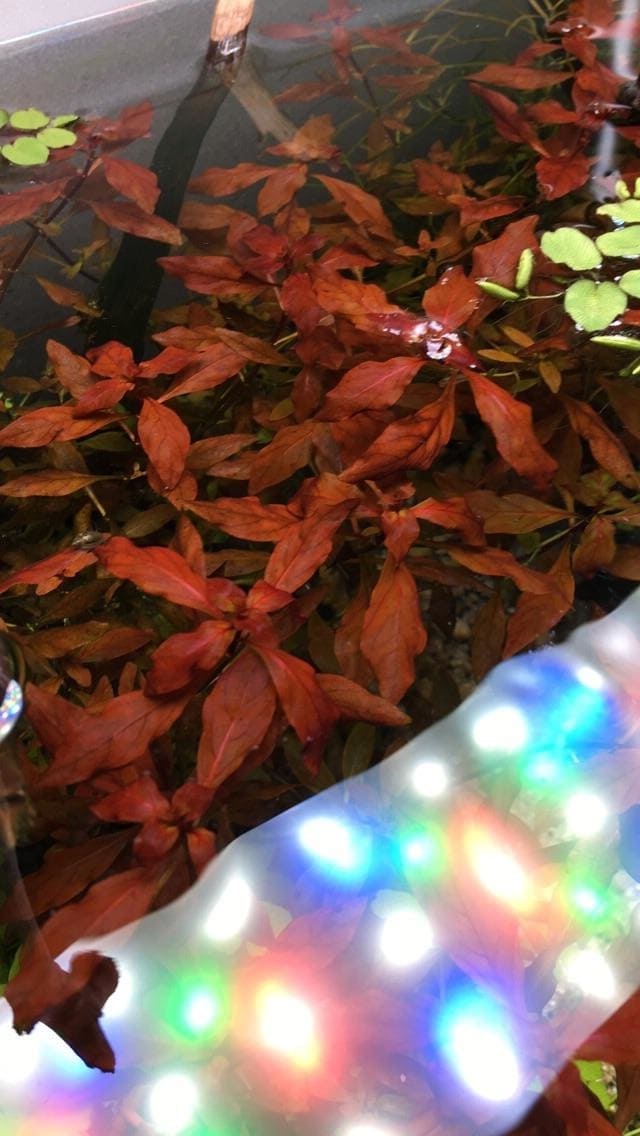
by disco_monster_
Author’s note: I have listed some of the best LED grow lights for aquarium plants and you can give them a skim by visiting this article.
Anyway, I’ve also noticed that injecting CO2 does help with the colors, but it’s not mandatory for a decent shade of red as with some other red plants.
Anyhow, Ludwigia natans “Super Red” may be among the easiest red plants to grow in your aquarium, but it does require some form of fertilization for optimal growth.
2. Alternanthera Reineckii “Mini”
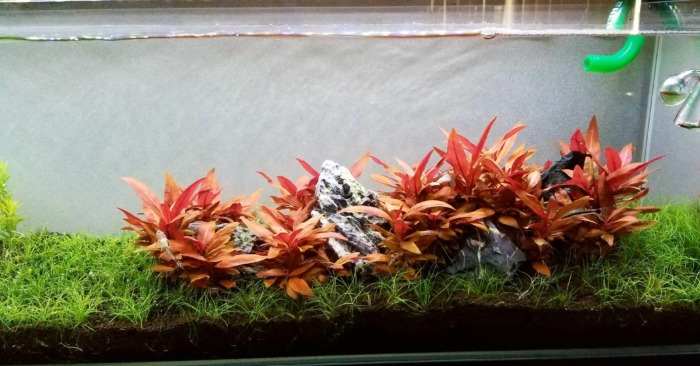
by Freshestemo412
- Suitable for a Beginner: Yes, but you should do some research beforehand;
- Suggested Lighting: I prefer strong for optimal results, but moderate lighting will also give a decent outcome;
- Growth Rate: Slow.
Alternanthera Reineckii Mini is a fantastic red plant that sits well in the foreground of the aquarium because of its bushy looks. It stays relatively small and short which makes it perfect for nano setups.
Alternanthera Reineckii Mini is from the Alternanthera genus which contains a range of aquatic and terrestrial species.
On the whole, it is not that difficult to look after and I’ve seen it do well in low-tech planted tanks.
The red colors were not as bright in that type of setup, but it’s a great plant to add some colors to a low-maintenance aquarium.
Author’s note: Alternanthera Reineckii Mini thrives under strong grow lights but the plant is somewhat susceptible to spot and hair algae on its leaves.
In my observations, black algae seems like the most common invader on AR Mini. To offset this you could use a little Flourish Excel, which is an algaecide that eliminates algae biofilm on plants.
I don’t like this method, because Excel can be a pretty nasty chemical in itself, but I’ve seen some situations that demand it.
After doing a cycle with Excel, try to maintain stable water parameters.
Each time I’m not consistent with my water parameters, my Alternanthera Reineckii Mini suffers in one way or another.

by Bigdaddykev
You may hear other experts saying that this plant does not like to be moved around and replanted.
I agree with that statement as each time I’ve done this the plant showed signs of extreme stress.
A common practice with this plant I’ve found effective is to cut its top portion when trimming.
This allows Alternanthera Reineckii Mini to become denser and shrub-like without stressing the plant itself.
Whatever you cut off – you can plant it elsewhere.
And, finally, I’ve had the best results with this plant when I’ve combined aqua soil capped with an inert aquarium substrate. You can learn why this works in my article about the best substrates for planted tanks.
3. Barclaya longifolia “Red”
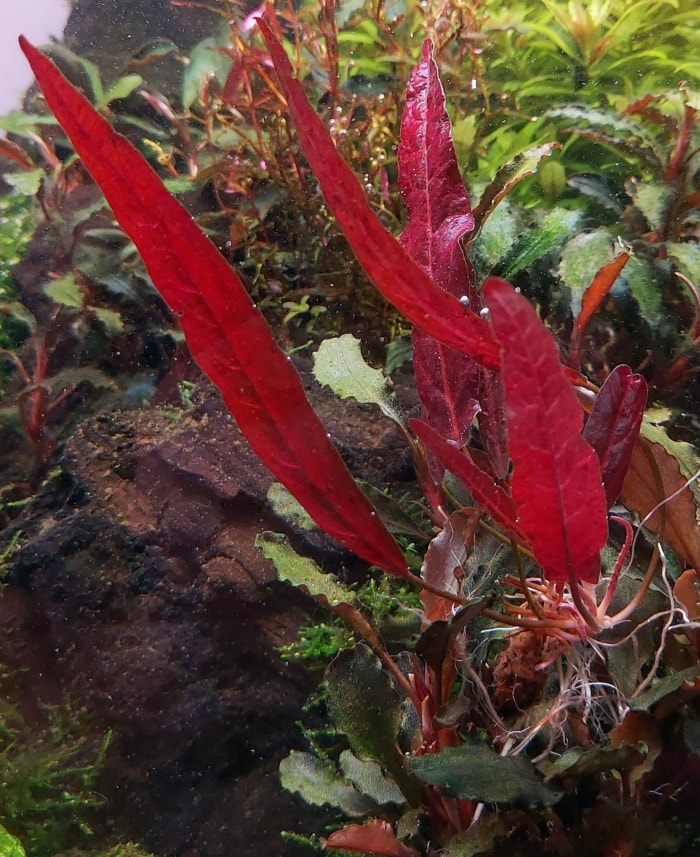
by Roland
- Suitable for a beginner: No
- Suggested lighting: High;
- Growth rate: Medium
The Barclaya longifolia from the Nymphaeaceae family is a gorgeous red water plant that’s best used as a background decoration.
It has long sword-like leaves that create a pleasant contrast in the company of green carpet plants.
However, to achieve this you’ll need to provide the Barclaya longifolia with high light, CO2, and fertilizers.
Otherwise, the leaves won’t turn red and will remain green instead.
Interestingly enough, the Barclaya longifolia belongs to the water lily family even though it doesn’t have any floating leaves.
When it’s properly cared for, this plant has a medium growth rate and can reach a maximum size of 16 inches. But just like other members of its family, you can slow down its growth by planting it into a small pot.
Author’s note: The Barclaya longifolia has tender leaves which are susceptible to snail attacks. Therefore, keeping this plant with aquarium snails isn’t advised.
4. Bacopa salzmannii “Purple”
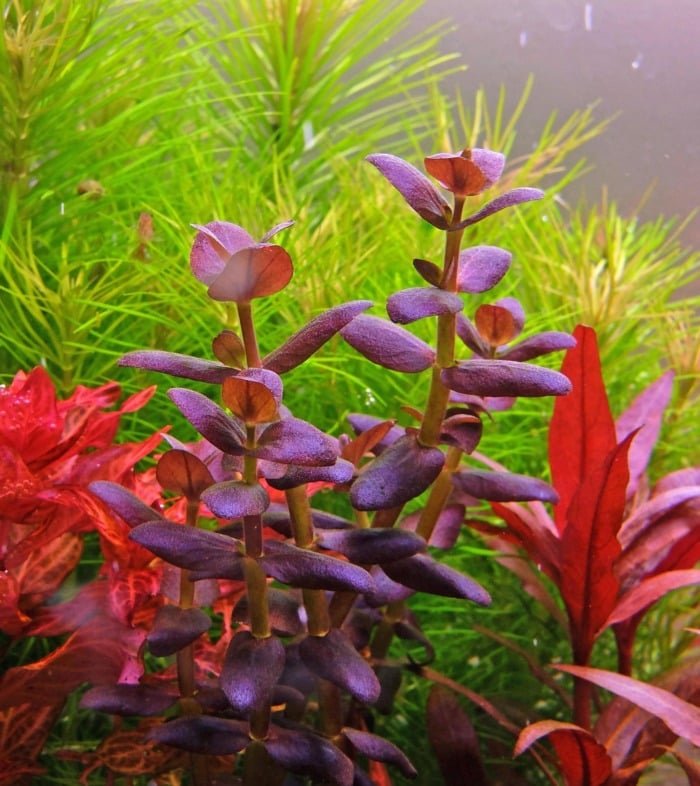
by Dennis_Wong
- Suitable for a Beginner: No, this plant requires softer water that’s also stable on other parameters, which may be difficult for the beginners to maintain;
- Suggested Lighting: Strong;
- Growth Rate: Fast if done properly.
Bacopa salzmannii has a lot of varieties, and the “Purple” type is the one I find most attractive in terms of coloration.
This fairytale-looking plant comes from the Bacopa genus that’s gained popularity as waterhyssop.
This plant has a deep purple color to it, which is why I included it in my list.
Even if you place it next to a red plant you will still achieve a good amount of contrast.
Aside from its distinctive violet color, Bacopa salzmannii has a unique-looking combination of a robust stem and leaves. This makes it a good addition to planted tanks that aim for a more diversified look.

by mei—
Anyway, Bacopa salzmannii “Purple” needs strong lighting to thrive and I wouldn’t put it in tanks with weak lights.
I usually place this plant in the middle ground of the aquarium where it would get the most incoming light possible but that also works well with surrounding plants.
I also make sure my Bacopa is not crowded by other plants that may cast shadows on it.
Author’s note: I would say that this plant does not require CO2 injections to turn purple. However, in that case, the colors will be paler and lean towards blue-ish. Though not necessary, I think you’d be compromising and will miss out if you’re not injecting Carbon Dioxide when looking after “Purple” Bacopa salzmannii.
5. Nymphaea zenkeri – Red Tiger Lotus
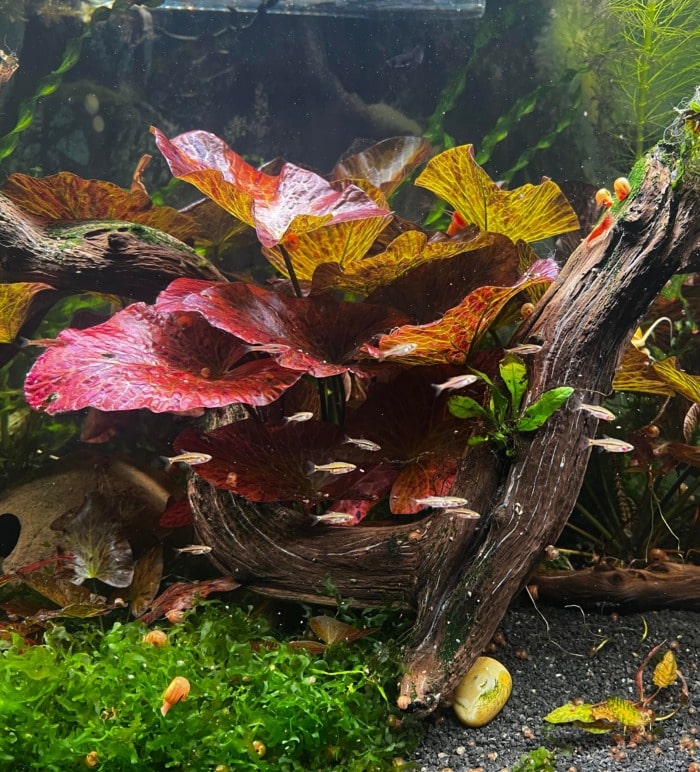
by cowrabbit
- Suitable for a Beginner: Yes, and is actually recommended;
- Suggested Lighting: Medium to strong;
- Growth Rate: Very fast.
The Red Tiger Lotus plant is basically a lily which has several implications that made me look into it:
- it grows really fast;
- it can flower once it has reached the water’s surface;
- it is relatively hardy as long as the water is not cold.
The Red Tiger Lotus can show a deep red color, with very little care, and for this reason, it is one of the best red plants for beginners in the aquarium hobby.
You can even have it in a low-tech tank, provided that you put some root tabs every 3 to 5 months, and that your aquarium lights are not weak. I’ve kept this plant many times over, and I’ve found that it needs medium-strength aquarium lighting to appear bright in color.
This typically means having 40 to 50 micromoles of PAR at the bottom of the tank.
CO2 is not needed for the Red Tiger Lotus, but if you decide to inject, you’ll enjoy a brighter pink color of the leaves.
Anyway, this red aquarium plant is what I would define as hardy.
The only requirement to keep it alive is having tropical water temperatures.
The Red Tiger Lotus is from а genus with a significant number of species known as Nymphaea. This means that the Red Tiger Lotus grows really fast and it will even survive in a goldfish habitat.
If you want to see the most coloration in your Nymphaea zenkeri, you can dose additional Iron to the tank.
Aquarium plants gain their red color from a group of compounds called Anthocyanins. Elevated Iron supply increases anthocyanins in plants and can therefore produce stronger red pigmentation. This may be so because metal ions such as Iron, and Magnesium improve the stability of anthocyanins, by forming what’s known as “complexes” with them.
Following these thoughts, most of us use tap water for our freshwater tanks, which is usually very rich in Magnesium but lacks adequate Iron for our red plants. Basically, all of this means that, when every requirement for your red plants is met, an increase in Iron can enhance their red colors.
Since the Red Tiger Lotus does not require much for optimal growth, it’s one of the plants that may benefit significantly from dosing additional Iron to the aquarium.
6. Phyllanthus fluitans – Red Root Floaters

by thenshesays
- Suitable for a Beginner: Yes;
- Suggested Lighting: Moderate to high for more redness of the surface leaves;
- Growth Rate: Fast spread.
The Red Root Floater from the very numerous genus Phyllanthus is a red floating plant that does not like a lot of water surface movement. Canister aquarium filters don’t disturb the surface of the water and are therefore recommended when looking after this plant.
You can see some of the better canister filters out there in this comparison article. Anyway, the Red Root Floater has deep red roots and surface leaves that will usually remain green if your lighting is not strong enough.
However, a good lighting source would bring out a stunning pink to red coloration in the leaves.
The roots will remain red no matter your light though, which is more than welcome for the side view of the aquarium.

by AquaticAnxieties
Anyhow, no CO2 is needed to grow your red root floaters because as floating aquarium plants they have access to Carbon Dioxide in the air.
It’s, in fact, why they grow so fast.
Author’s note: Like most floating plants, the Red Root Floater will quickly spread all over the water surface. If you let it do so, it will block the light from reaching the bottom of your tank and the live plants on the substrate will suffer. To avoid that, you can simply use a floating plant ring to contain the floaters to the perimeter of the tank’s surface.
7. Ludwigia arcuata
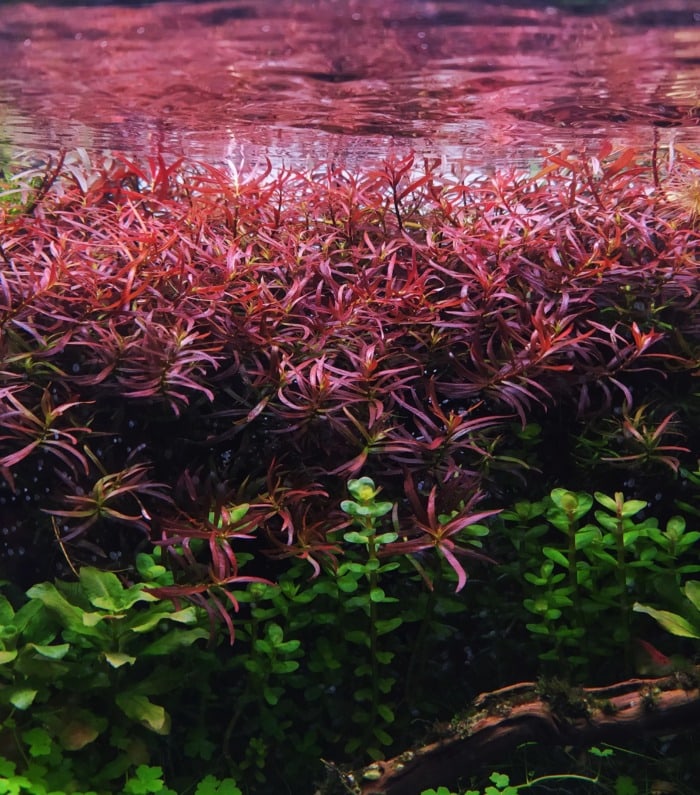
by Sefrix_666
- Suitable for a Beginner: No;
- Suggested Lighting: Medium to strong;
- Growth Rate: Medium.
Ludwigia arcuata is one of the few aquarium plants that will become a deep red color if you grow it in a tank with very low to no Nitrate. If Nitrate in the water is not limited this plant will turn dark orange.
Nevertheless, this Ludwigia arcuata, a member of the Ludwigia genus, is a really cool plant that you can grow in the back of your planted tank.
It usually takes on this bush-like form and sits well as background decoration.
Anyway, up in the summary, I’ve listed Ludwigia arcuata as not being beginner-friendly.
That’s solely because of its requirement for Nitrate starvation if you wanted to achieve the deep red coloration.
Aside from that, I think that a beginner in high-tech tanks and red aquarium plants can still grow Ludwigia arcuata pretty successfully.
However, I’d advise you not to skip on the CO2 with this plant.
8. Ludwigia inclinata var. verticillata “Pantanal”
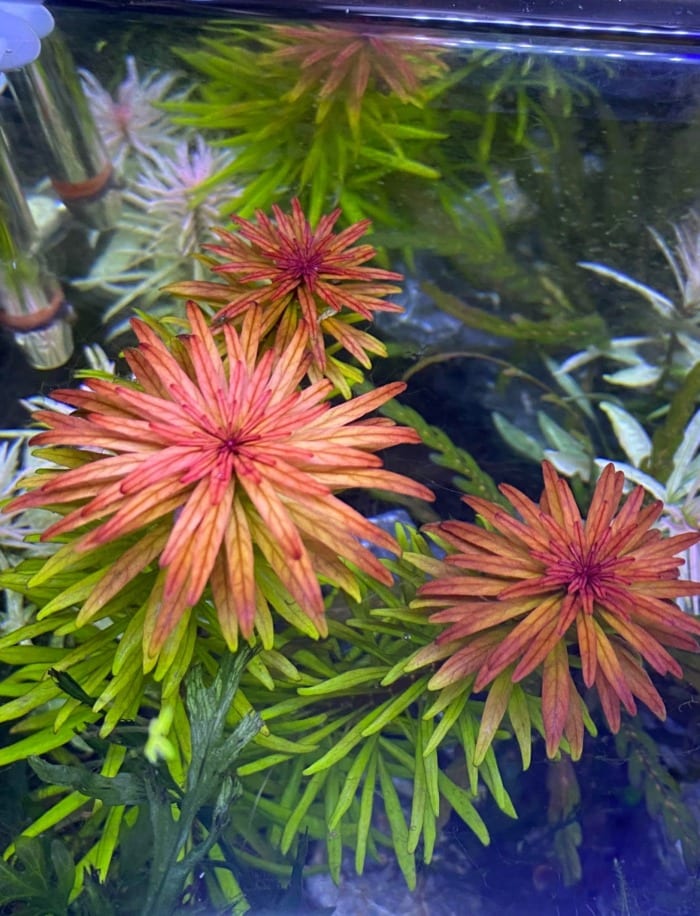
by Sjcamacho04
- Suitable for a Beginner: Depends, the plant requires a lot from everything, and it can be challenging for a newcomer to sustain the conditions long-term;
- Suggested Lighting: High light;
- Growth Rate: When all is well, it grows really fast.
Let’s pretend the name of this plant was not overly complicated and simply use Ludwigia Pantanal instead.
Anyway, Ludwigia Pantanal is a very demanding plant from the Ludwigia genus, and I would advise not to compromise with its requirements.
If you want this aquarium plant to thrive and actually become red you need to provide it with high lighting, a good amount of dissolved Carbon Dioxide, and a water column rich in Nitrate.
I wouldn’t recommend putting Ludwigia Pantanal in a tank where you plan to do Nitrate starvation, because the plant will not like that.
If the plant is not satisfied its red colors will slowly fade, and then turn to yellow or green like shown here:
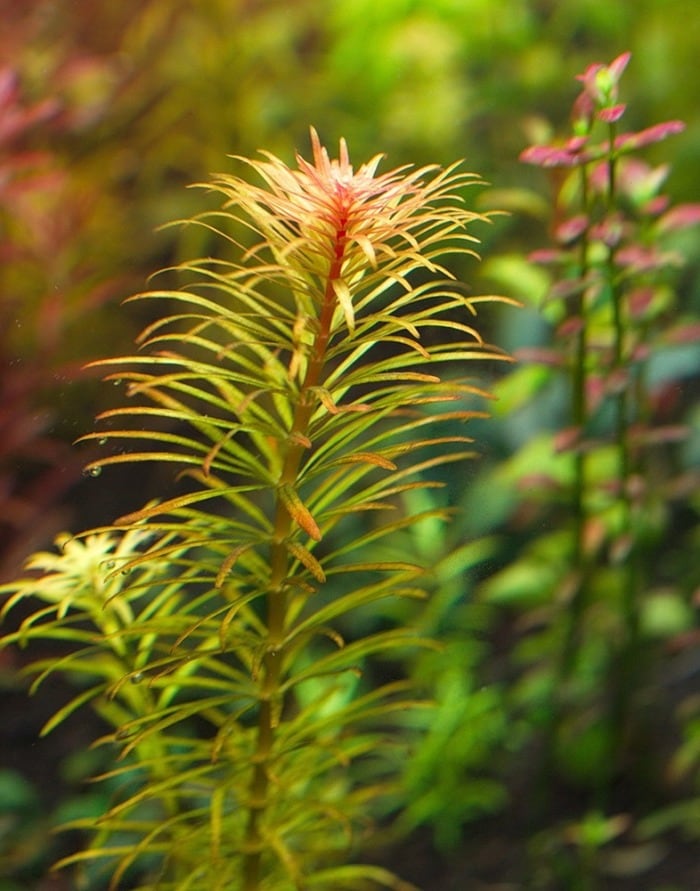
by erwin123
Author’s note: Make sure you have a reliable CO2 regulator because this plant requires fairly aggressive CO2 injections. If you still haven’t done research on CO2 regulators, you can check the top-rated ones by visiting this article.
9. Ammania gracilis
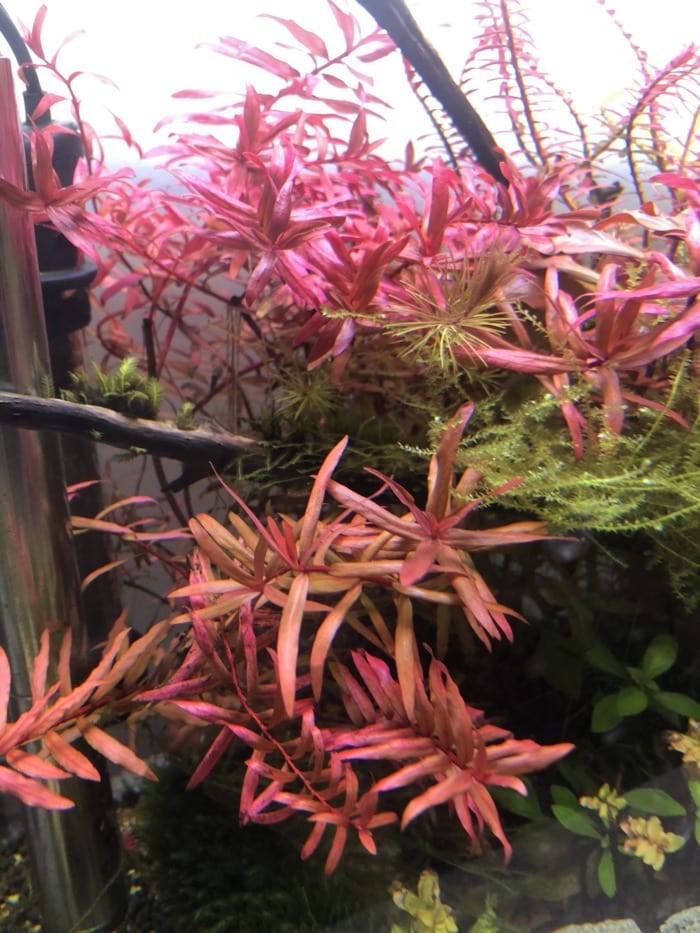
by rxcheng
- Suitable for a Beginner: Not difficult to keep alive, but difficult to bring out the stunning pink hue;
- Suggested Lighting: Strong;
- Growth Rate: Moderate.
I’ve found that Ammania gracilis is a rather capricious plant.
To make it show its beautiful pink coloration a decent amount of light should be hitting it.
Not surprisingly, this plant and the other around 100 species of the Ammannia genus are often referred to as redstems.
Also, same as Ludwigia Pantanal, Ammania gracilis needs up to 30 ppm of dissolved CO2.
Not only that, but you should also limit the Nitrate content in the water column if you expect to witness this plant color up properly.
Stable water that’s on the softer end is also something you should be able to maintain…
All in all, this is not a plant I would recommend for just starting out with high-tech aquariums.
10. Trithuria lanterna

by Dennis_Wong
- Suitable for a Beginner: No;
- Suggested Lighting: Strong;
- Growth Rate: Medium.
The Trithuria lanterna belongs to the genus known as Trithuria.
Trithuria lanterna is one difficult carpeting plant. Its grass blades remain small and have a red base, which can make for an attractive foreground in your red plant aquarium.
I personally don’t like how demanding this plant is but it looks very cool and it contributes to a tank with red plants.
What’s important to grow Trithuria lanterna successfully is having it in a well-lit area that receives a good amount of CO2 through water flow.
This in itself can be challenging for a beginner, but that’s not what I dislike about looking after this plant. What puts me off the most is that, unlike DHG for example, Trithuria lanterna cannot propagate on its own.
You need to manually spread each clutch if you want to achieve the carpet look.
11. Hygrophila chai
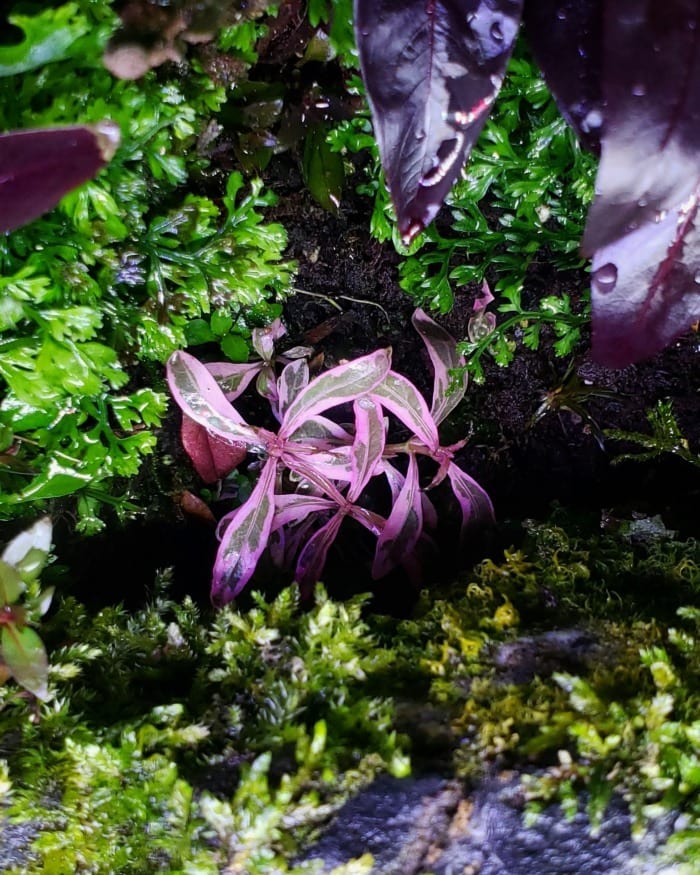
by kvlopsia
- Suitable for a Beginner: No;
- Suggested Lighting: Very high;
- Growth Rate: Slow.
I just wanted to include this beautiful pink plant as a reference for beginners who will eventually turn to growing more challenging plants.
This breathtaking plant comes from the Hygrophila genus, more popular as swampweeds.
Hygrophila chai is not something I would try growing unless I felt confident in my plant husbandry.
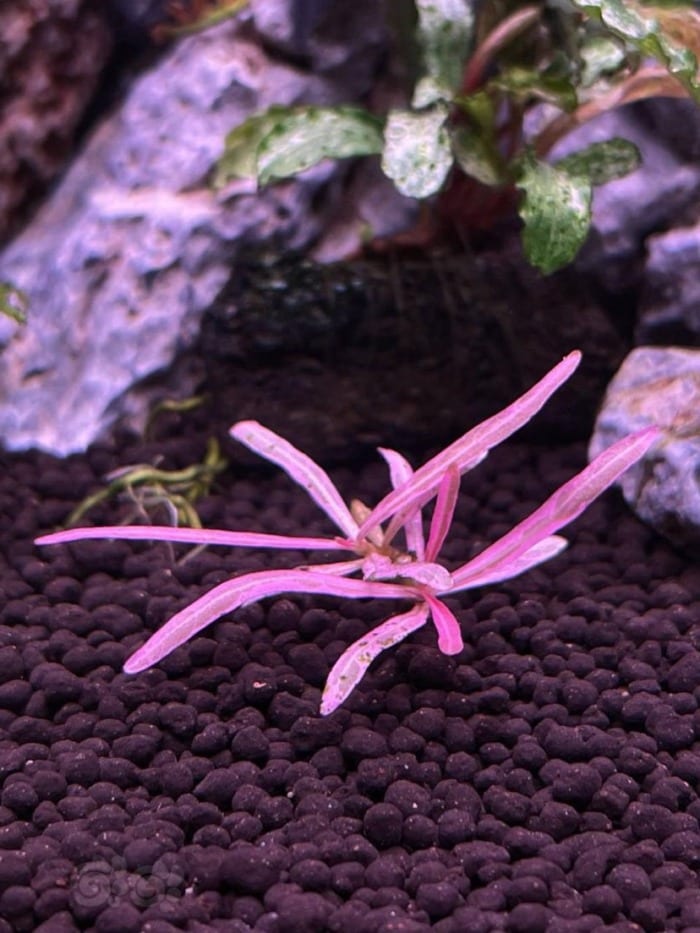
by nanachuai
You need to be a master in maintaining a stable planted aquarium if you want the pink Hygrophila chai to decorate yours.
Nevertheless, it has a stunningly unique look and it provides a good contrast in a tank with red and green plants.

by nanachuai
Author’s note: I rarely mention pricing when it comes to freshwater aquarium plants because it’s usually a negligible number. However, keep in mind that Hygrophila chai is fairly expensive. Its price can be off-putting even for experienced aquarists who want to try it out for the first time.
12. Rotala Rotundifolia “Red”
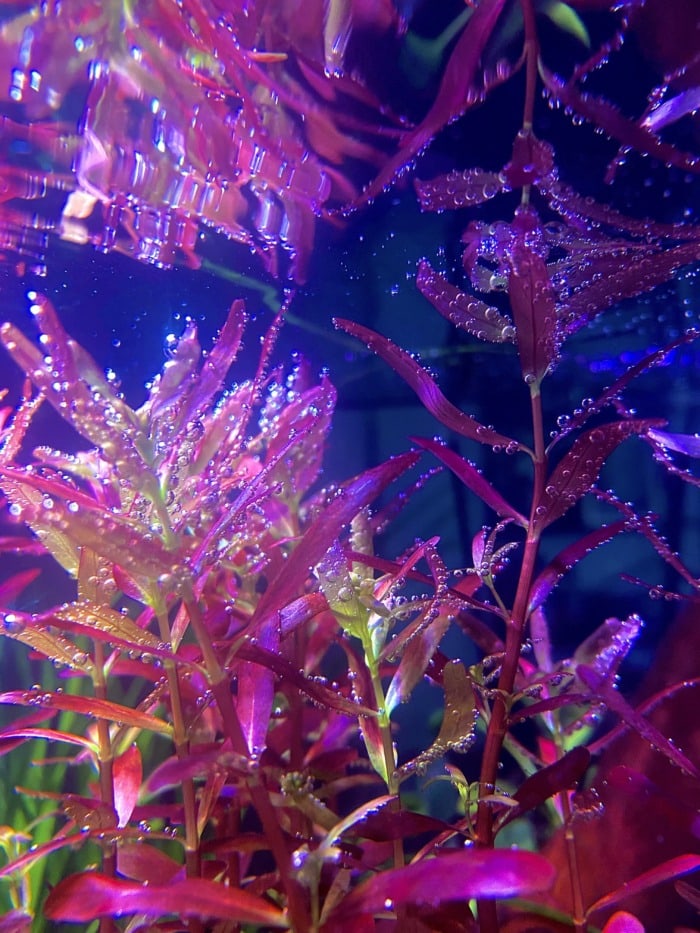
- Suitable for a Beginner: Yes;
- Suggested Lighting: Strong;
- Growth Rate: Rapid.
Rotala rotundifolia has many varieties and “red” is one of them.
Typically, it’s an easy plant to grow and it requires strong lighting to turn red or dark orange in color. The coloration of Rotala rotundifolia “Red” also benefits from limited Nitrate levels in the water.

by mgeorges
I’ve also found that CO2 injections can help but are not a necessity as with some more demanding red plants.
Rotala rotundifolia “Red” is likely one of the easiest aquarium plants you can try growing in your new high-tech tank. However, if you’d like to see its potential for deep redness, you should be experienced in limiting high Nitrate.
Author’s note: Since it’s a stem plant, this species from the Rotala genus will try to outgrow your tank in height. Luckily for us aquascapers, it’s easy to shape the plant into a bush with some regular trimming.
13. Lagenandra Meeboldii “Red”

by aquabotanicae
- Suitable for a beginner: Yes
- Suggested lighting: Medium
- Growth rate: Medium
Despite its name, the Lagenandra Meeboldii “Red” is an easy to grow, pink aquarium plant.
It bears a striking resemblance to the Cryptocorine Wendtii, but unlike it, its leaves are more rounded.
While it can be grown under low lighting without any CO2, this will result in duller colored leaves.
So if you want your Lagenandre Meeboldii to show its true colors, I suggest you use medium lighting and CO2 injections.
Additionally, planting it in a nutrient-rich aquarium soil will further saturate its pink color.
The Lagenandra Meeboldii is mostly used as a midground plant in regular sized aquariums, but can also be used as a foreground in smaller tanks.
You should keep in mind that this is a slow growing aquarium plant, so you’ll need some patience before you can feast your eyes on its beauty.
How to make aquarium plants even redder?
Typically, looking after aquarium plants that have a solid red color comes down to one thing – stronger light in the right spectrum.
Following these thoughts, I recommend going with LED aquarium lighting for achieving the needed intensity and spectrum.
There’s way more control and efficiency with LED grow lights.
Apart from that, dissolved CO2 does improve the color brightness in aquatic plants but is not responsible for the color itself.
From then on it’s all about nutrient density and it becomes strictly species-dependent.
Some plants may color up with the lack of a certain nutrient while others won’t do well without it.
My Personal Conclusion
Creating a visually pleasing aquascape is all about color balance.
By adding red, purple or pink aquarium plants to your setup you can turn an otherwise boring fish tank into an aquatic wonderland.
I hope this post helped you find what you were looking for.
Feel free to share pictures of your aquascapes down in the comments.


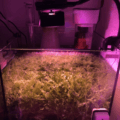

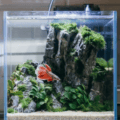
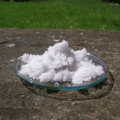


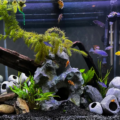

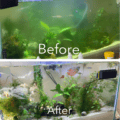

1 thought on “13 Red Aquarium Plants (+Some Purple & Pink Ones)”